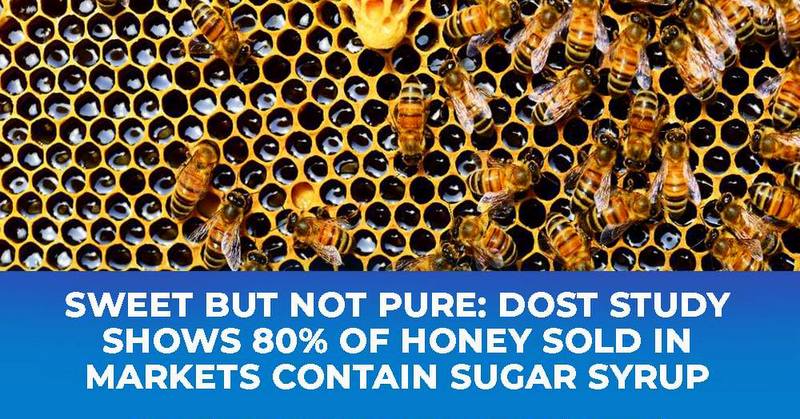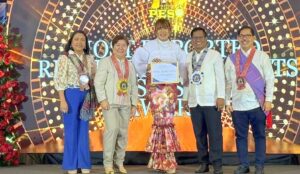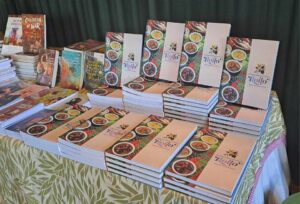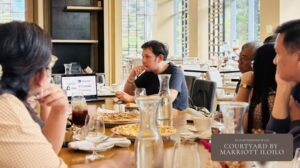DOST: 82% of honey sold in PH not pure

DOST study on pure honey
- DOST researchers said that 82% of PH honey products in the market contain sugar syrup.
- On the other hand, all 41 imported honey tested are pure.
Department of Science and Technology-Philippine Nuclear Research Institute (DOST-PNRI) revealed that most of honey products sold in the Philippines are not really honey but ‘completely purely sugar syrup.’
In a result of nuclear-based studies of their researchers, DOST said that about 80% of honey products sold in groceries, souvenir shops, and online platforms contain syrups made from sugar cane and corn. This fraudulent practice allows manufacturers to increase the volume of their products while reducing production costs.
“62 out of the 76 (82%) of honey brands that were found to be adulterated were composed of 95% C4 sugar syrup. So, they are not actually adulterated but they are just completely purely sugar syrup,” said DOST-PNRIDr. Angel T. Bautista VII.
Dr. Bautista explained the extent of impure honey proliferated the Philippine market. According to him, 12 out of 16 or 75% of local honey brands sold either in groceries or souvenir shops are not entirely honey. In addition, a staggering 87% or 64 out of 74 of local honey products sold online are impure. Lastly, from 41 imported honey products marketed in local stores, none of them were found to be adulterated.
“The problem is that people are being tricked,” Dr. Bautista remarked. “You may be buying honey for its wonderful health benefits, but because of adulteration, you may actually just be buying pure sugar syrup. Consuming too much pure sugar syrup can lead to harmful health effects,” he added.
Impure honey can seriously damage the local industry for it can pull down the price of honey. Fake honey can be sold as low as one-third of the original price of the authentic honey.
“Imagine, incomes that are supposed to be for our honest beekeepers and honey producers are being lost instead due to adulteration and fraud. This is affecting our local honey industry so badly that we estimate that they are losing PhP200 million per year,” Dr. Bautista lamented.
According to the Philippine National Standard for Honey of the Bureau of Agriculture and Fisheries Standards, honey sold in the market must not have any food additives and other substances. If so, any substance added to the mixture must be declared in the labeling. Moreover, the geographical location where the honey was sourced should be written in labels.
Nuclear science fights food fraud
Honey is one of the most common food items being replicated all over the world. While its demand can make honey farming a promising business, it also became a subject of fraudulent production.
The DOST-PNRI researchers came up with these surprising, sobering findings through the stable carbon isotope ratio analysis.
This type of analysis allows researchers to see isotopes – elements with same number of electrons and protons but different number of neutrons – which can give clues on the origin of the substance. If honey is authentic, its protein content will show carbon isotopes that match those of flowering plants and bees. However, adulterated honey will have carbon isotopes which can be traced from sugarcane and corn.
“The carbon-13 signature is like a fingerprint of honey and common adulterants like sugarcane and corn are completely different from each other. Therefore, we can differentiate one from the other. This unique isotopic signature is what we are using to tell if honey is authentic or fake,” Dr. Bautista explained.
The carbon-13 he refers to is the stable isotope of carbon. The carbon-13 in a substance like honey can be used to trace the biological processes it went through.
To make honey, the bees start with sipping nectar from flowers using their straw-like tongue called proboscis. The enzymes in their gut will then process the nectar. Once done, they will vomit it and pass on to other bees of their colony. This process called regurgitation turns complex sugars of nectar into simple sugars. Next, they will store the regurgitated nectar in their hive and reduce its water content by flapping their wings. To cap it off, they will cover it with beeswax to complete the honey-making process.
These processes have fingerprints of carbon isotopes which are important for checking the authenticity of honey.
Dr. Bautista and his team has already forwarded their findings to the Department of Agricultureand the Food and Drug Administration.
“If we just release the names of the companies, they may stop for a while. But no one can stop them from faking honey again in the future. If we incorporate these isotope-based standards into our regulatory system and the Philippine National Standards, then we think it will be long-lasting solution to this problem,” Dr. Bautista reported.
They also call for stricter policies, regulation, and control measures to protect the honey industry and buyers.
Dr. Bautista leads a laboratory which studies application of nuclear and isotope techniques in the environment, geology, and food authentication. Joining him in this study are Marco R. Lao and Norman DS. Mendoza, also from DOST-PNRI, and Dr. Cleofas F. Cervancia, a retired professor at the University of the Philippines Los Baños (UPLB) who previously led its Bee Program. They presented their DOST-funded study in the Philippine Nuclear Research and Development Conference, which was held online during the Atomic Energy Week of DOST-PNRI on 09 December 2020. (via DOST)







